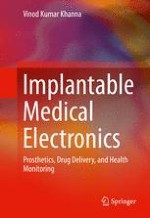2016 | OriginalPaper | Buchkapitel
16. Deep Brain Stimulation
verfasst von : Vinod Kumar Khanna
Erschienen in: Implantable Medical Electronics
Aktivieren Sie unsere intelligente Suche, um passende Fachinhalte oder Patente zu finden.
Wählen Sie Textabschnitte aus um mit Künstlicher Intelligenz passenden Patente zu finden. powered by
Markieren Sie Textabschnitte, um KI-gestützt weitere passende Inhalte zu finden. powered by
